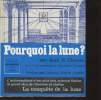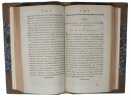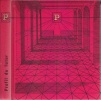-
Type
Book (4568)
Magazine (53)
Photographs (3)
-
Latest
Last 24h (8)
Last 3 days (2)
Last month (16)
Last week (13)
-
Language
Dutch (2)
English (8)
French (4607)
German (2)
Italian (1)
Latin (3)
Swedish (1)
-
Century
16th (13)
17th (11)
18th (137)
19th (550)
20th (2385)
21st (264)
-
Countries
Belgium (339)
Côte d'Ivoire (4)
Denmark (178)
France (3840)
Italy (39)
Switzerland (224)
-
Syndicate
CLAM (8)
ILAB (2821)
NVVA (90)
SLACES (90)
SLAM (2482)
SNCAO (14)
La connaissance de l'Univers
Editions du Seuil , Rayon de la Science Malicorne sur Sarthe, 72, Pays de la Loire, France 1963 Book condition, Etat : Bon broché In-8 1 vol. - 188 pages
nombreuses Contents, Chapitres : structures d'ensemble, microscopique - théories unitaires - vie - psychisme - évolution format de poche
Pourquoi la lune ? Avec la collaboration de Jean-Marc Brissaud
Planète, coll. « L’encyclopédie planète » 1968 In-12 cartonnage éditeur pleine toile blanche illustrée 18,2 cm sur 16. 256 pages. Jaquette en bon état. Bon état d’occasion.
Directeur Louis Pauwels ; Comité de direction Jacques Bergier ; Louis Pauwels ; François Richaudeau Bon état d’occasion
"Pourquoi la Lune ? n°33 (Collection : ""L'encyclopédie Planète"")."
Planète. 1968. In-8. Relié toilé. Bon état, Couv. convenable, Dos satisfaisant, Intérieur frais. 255 pages augmentées de nombreuses photos et illustrations en noir et blanc dans et hors texte. Texte sur deux colonnes. Rhodoïd et bandeau d'éditeur en bon état.. . . A l'italienne. Classification Dewey : 520-Astronomie et sciences connexes
"Collection : ""L'encyclopédie Planète"". Préface de l'Amiral André Jubelin. Classification Dewey : 520-Astronomie et sciences connexes"
Guide du ciel, pour astronomes amateurs.
BROQUET Marcel. 1984. In-12. Broché. Etat d'usage, Couv. défraîchie, Dos plié, Mouillures. 280 pages. Nombreuses planches de cartes en noir et blanc ou en couleurs hors-texte. Page de titre frottée. Quelques pages collées à cause des mouillures.. . . . Classification Dewey : 520-Astronomie et sciences connexes
Guide d'identification. Traduit par Gilles et Guy Ménard. Illustré par H. Wimmer. Classification Dewey : 520-Astronomie et sciences connexes
Photo-guide du ciel nocturne - Collection Les photo-guides du naturaliste.
Delachaux et niestlé. non daté. In-8. Broché. Etat d'usage, Coins frottés, Dos satisfaisant, Papier jauni. paginé de 47 à 718 pages, nombreuses planches d'illustrations en couleur - couverture reliée en sens inverse du corps de l'ouvrage, tranches frottées, petits accros sur le 1er plat.. . . . Classification Dewey : 520-Astronomie et sciences connexes
Collection Les photo-guides du naturaliste. Classification Dewey : 520-Astronomie et sciences connexes
Galileo Galilei.. Sa vie, son procès et ses contemporains d'après les documents originaux. Avec un portrait gravé d'après l'original d'Ottavio Leoni
Paris, Poulet-Malassis [Imprimerie Simon Raçon], 1862 in-8, [2] ff. n. ch., VIII pp., 286 pp., un f. n. ch. d'errata, manque le portrait par Bracquemond, demi-basane noire modeste, dos lisse orné de pointillés et filets dorés, tranches mouchetées (reliure de l'époque). Deux coiffes rognées.
Édition originale dédiée à Alfred von Reumont, envoyé du Roi de Prusse à Florence, et qui avait prêté à Chasles (1798-1873) les documents utilisés pour cette biographie.Vicaire II, 274. Oberlé, Poulet-Malassis, 343.RELIÉ À LA SUITE : MARON (Eugène) : Histoire littéraire de la Convention nationale. Paris, Poulet-Malassis et de Broise, 1860, titre, 359 pp., manque le faux-titre. Oberlé, p. 255 (s.v.). Un des rares ouvrages de cet historien qui a très peu publié. Il fait suite à son Histoire littéraire de la Révolution. Constituante, Législative (parue en 1856 chez Chamerot). Éloquence. - Instruction publique. - Théories sociales. - Journalisme politique. - Idées morales et religieuses. - Critique et poésie. - - VENTE PAR CORRESPONDANCE UNIQUEMENT
DICTIONNAIRE DE METEOROLOGIE POPULAIRE
MAISONNEUVE ET LAROSE. 1989. In-8. Broché. Bon état, Couv. convenable, Dos satisfaisant, Intérieur frais. 401 pages.. . . . Classification Dewey : 520-Astronomie et sciences connexes
Classification Dewey : 520-Astronomie et sciences connexes
Cours de cosmographie à l'usage de la classe de philosophie.
Paris Librairie Hachette. 1932 148p 1 volume In16 en cartonnage vert éditeur. Couverture imprimée.
ELEMENTS DE COSMOGRAPHIE - A l'usage de la classe de Philosophie de l'Enseignement secondaire.
LIBRAIRIE HACHETTE. NON DATE. In-12. Relié. Etat d'usage, Couv. convenable, Dos satisfaisant, Papier jauni. 148 pages - pages augmentées de nombreuses planches photos et illustrations en noir et blanc dans et hors texte - NOMBREUSES COUPURES DE PRESSE.. . . . Classification Dewey : 520-Astronomie et sciences connexes
COPYRIGHT 1932. Classification Dewey : 520-Astronomie et sciences connexes
ELEMENTS DE COSMOGRAPHIE, A L'USAGE DE LA CLASSE DE PHILOSOPHIE DE L'ENSEIGNEMENT DU SECOND DEGRE
Hachette. 1932. In-12. Relié. Bon état, Couv. convenable, Dos satisfaisant, Intérieur bon état. 148 pages. Illustré de nombreuses photo-gravures en noir et blanc hors texte en fin d'ouvrage.. . . . Classification Dewey : 520-Astronomie et sciences connexes
Ellipse, Parabole. Mouvement diurne. La Terre. Le Soleil. Les planètes. Comètes... Classification Dewey : 520-Astronomie et sciences connexes
ELEMENTS DE COSMOGRAPHIE, CLASSE DE PHILOSOPHIE
Hachette. 1934. In-12. Relié. Bon état, Couv. convenable, Dos satisfaisant, Intérieur bon état. 148 pages. Illustré de nombreux schémas en noir et blanc, et de planches hors texte en noir et blanc. Annotation au dos du 1er plat. Pages légèrement jaunies.. . . . Classification Dewey : 520-Astronomie et sciences connexes
Conforme aux programmes officiels d'avril 1931. Ellipse, parabole. Mouvement diurne. Le soleil. Mesure du temps... Classification Dewey : 520-Astronomie et sciences connexes
Eléments de cosmographie à l'usage de la classe de philosophie de l'enseignement du second degrè.
Paris, Hachette, 1932, in-12 cartonnage éditeur, quelques illustrations et 18 planches dans le texte, 148 pp. Rares et infimes rousseurs, sinon très bon état.
Les Origines de l'Astronomie Chinoise.
Paris, Librairie orientale et américaine, Maisonneuve, 1930. Grand et fort in-8 de X et 594 pages. Nouvelle édition photomécanique. Figures in-texte. Très bon état intérieur. Broché. . Nombreux tampons de Radio France et ORTF. En très bon état.
Radioastronomie
Editions des langues etrangères. 1958. In-8. Relié toilé. Bon état, Couv. convenable, Dos satisfaisant, Intérieur frais. 324 pages. de très nombreuses illusrations noires dans et hors texte. Petite mouillure.. . . . Classification Dewey : 520-Astronomie et sciences connexes
Classification Dewey : 520-Astronomie et sciences connexes
Berichtigung, einen angeblichen Meteorstein betreffend (+) Einige kosmologische ideen, die Vermehrung oder Verminderung der Masse eines Weltkörpers betreffend.
Halle, Rengerschen Buchhandlung, 1805. 8vo. In contemporary half calf with five raised bands and gilt lettering to spine. In: ""Annalen Der Physik"", 19. Band. Entire volume offered. Light wear to extremities, primarily spine. Two stamps to verso of title-page and stamp to verso of each plate. Otherwise a fine copy. Chladni's papers: p. 243" Pp. 257-281. [Entire volume: (8), 496 pp. + 8 plates].
First appearance of Chaldni's two paper, the first being a correction to a previous paper, the second being his thoughts on the gap between Mars and Jupiter.
Tables des positions planétaires de 1850 à 1950
Paris, Chacornac frères 1953 184pp., br.orig., 8e édition revue et augmentée
Le pouvoir de l'univers est en vous - Partez à la découverte de votre origine cosmique.
Guy Trédaniel. 2017. In-8. Broché. Bon état, Couv. convenable, Dos satisfaisant, Intérieur frais. 323 pages.. . . . Classification Dewey : 520-Astronomie et sciences connexes
Best-seller du new york times. Classification Dewey : 520-Astronomie et sciences connexes
LA DOMIFICATION - COMMENT CALCULER ET MONTER UNE CARTE DU CIEL POUR TOUS LES PAYS DE LA TERRE
DERVY. 1958. In-12. Broché. Etat d'usage, Couv. défraîchie, Agraffes rouillées, Intérieur frais. 37 pages - nombreuses figures en noir et blanc in et hors texte. . . . Classification Dewey : 520-Astronomie et sciences connexes
Classification Dewey : 520-Astronomie et sciences connexes
La Domification. Comment calculer et monter une carte du ciel pour tous les pays de la terre.
DERVY-LIVRES. 1978. In-12. Broché. Bon état, Couv. convenable, Dos satisfaisant, Intérieur frais. Plaquette de 34 pages. Quelques figures en noir et blanc, dans le texte.. . . . Classification Dewey : 520-Astronomie et sciences connexes
"Préface de A. VOLGUINE. Collection ""La Roue Céleste"". Classification Dewey : 520-Astronomie et sciences connexes"
10 th annual meeting on upper atmospheric studies by optical methods
Observatoire de Besançon. 1982. In-4. Broché. Bon état, Couv. convenable, Dos satisfaisant, Intérieur frais. 313 pages augmentées de quelques figures en noir et blanc dans texte.. . . . Classification Dewey : 520-Astronomie et sciences connexes
Etiquette sur coiffe en pied. Tampon bibliothèque. texte écrit en anglais. Classification Dewey : 520-Astronomie et sciences connexes
Profil du futur.
Couverture rigide. Reliure de l'éditeur. 252 pages. 16 x 18 cm.
Livre. Préface de Henri Prat. Editions Planète (Collection : L'encyclopédie Planète), Vers 1970.
Profil du futur.
Couverture rigide. Reliure de l'éditeur. 252 pages. 16 x 18 cm. Rhodoïd.
Livre. Préface de Henri Prat. Editions Planète (Collection : L'encyclopédie Planète), Vers 1970.
Profil du futur.
Couverture rigide. Reliure de l'éditeur. 252 pages. 16 x 18 cm.
Livre. Préface de Henri Prat. Editions Planète (Collection : L'encyclopédie Planète), Vers 1970.
2010 - ODYSSEE DEUX
FRANCE LOISIRS. 1984. In-8. Broché. Bon état, Couv. convenable, Dos satisfaisant, Intérieur frais. 295 pages. Jaquette avec quelques déchirures et pliures.. . . . Classification Dewey : 520-Astronomie et sciences connexes
Classification Dewey : 520-Astronomie et sciences connexes
Description et usage de l'astrolabe à prisme
Gauthier-Villars, Imprimeur-Libraire à Paris Malicorne sur Sarthe, 72, Pays de la Loire, France 1910 Book condition, Etat : Bon broché, sous couverture imprimée éditeur crème grand In-8 1 vol. - 422 pages
7 planches hors-texte en fin d'ouvrage (complet) et une quarantaine de figures dans le texte en noir 1ere édition, 1910 Contents, Chapitres : Avant-propos, Introduction, xxx, Texte, 392 pages - De l'astrolabe à prisme - Instruments de M. Jobin - Méthode des hauteurs égales pour la détermination de la latitude et de l'heure locale, son application au cas particulier des hauteurs observées avec l'astrolabe à prisme - Détermination des longitudes géographiques par les hauteurs égales de Lune et d'étoiles - Préparation des observations - Identification des étoiles observées - Pratique des observations et des calculs - Note : Conditions de parallélisme des rayons lumineux quelconques effectués à l'intérieur d'un prisme bel exemplaire, couverture propre, intérieur frais et propre (dos et bords des plats légèrement brunis) - cachet de géomètre sur la première page
 Write to the booksellers
Write to the booksellers















